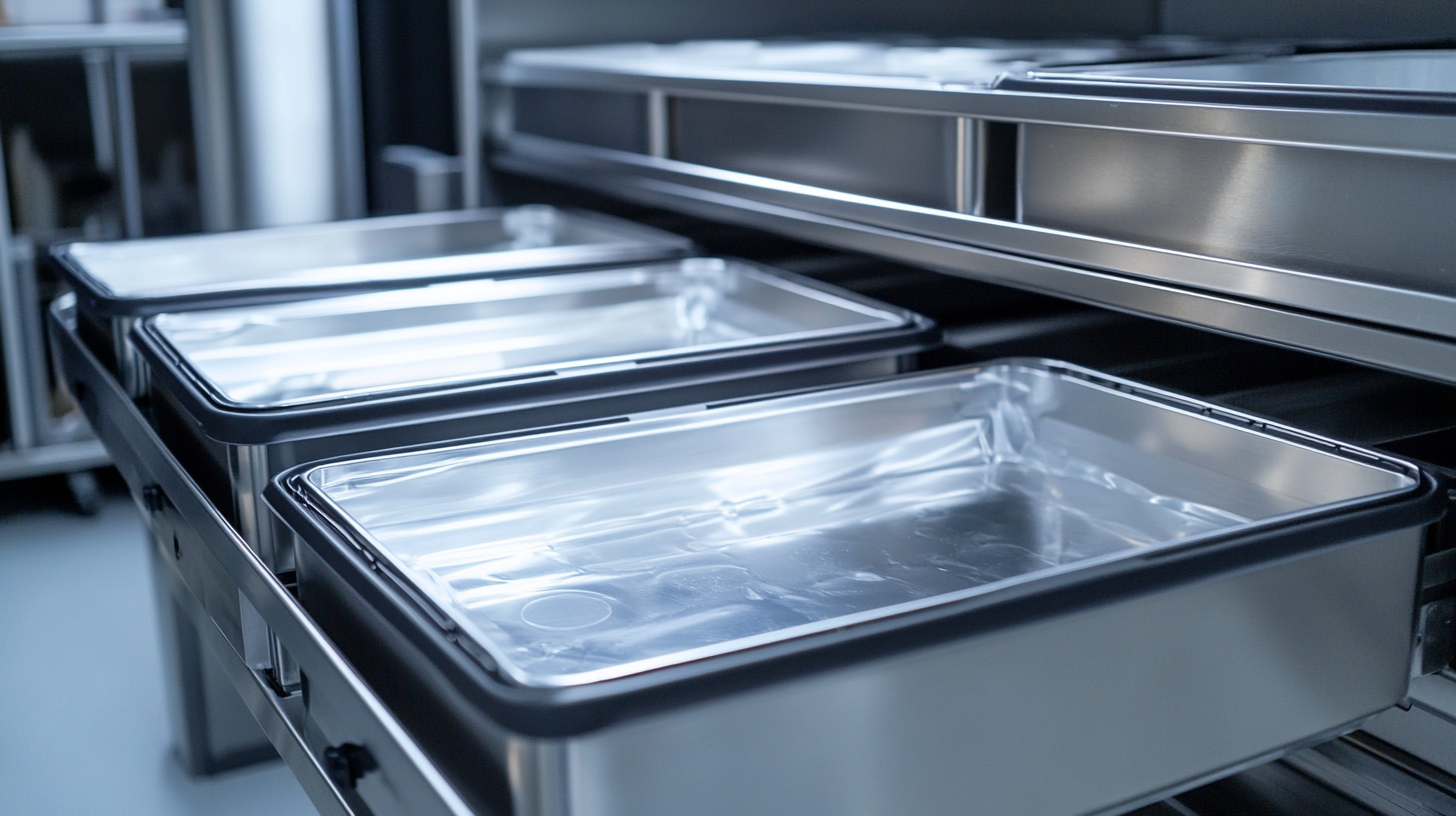- +86-13631182173
- sales@zsqeelin.com
- 8613631182173
In a world where quality and efficiency drive consumer choices, the importance of superior manufacturing capabilities cannot be overstated, particularly in the realm of household appliances. The fridge crisper drawer, a seemingly simple yet crucial component of modern refrigerators, embodies the intersection of functionality and innovation. This blog delves into the intricate processes and standards upheld by leading fridge crisper drawer factories, paving the way for exceptional products that enhance food preservation and organization. With a commitment to excellence, these manufacturing facilities not only prioritize the use of high-quality materials but also integrate cutting-edge technology to ensure durability and performance. As we explore the benchmarks of excellence in this specialized sector, we will highlight how these factories achieve quality without compromise, setting new standards in fridge crisper drawer production that benefit both manufacturers and consumers alike.

In today's competitive landscape, innovative technologies are at the forefront of crisper drawer production, redefining industry standards. Advanced materials, such as high-grade plastics and environmentally-friendly composites, enhance durability while maintaining lightweight characteristics. This not only improves energy efficiency within the fridge but also ensures that fruits and vegetables remain fresh for longer periods. Furthermore, manufacturers are leveraging smart technologies, integrating sensors and monitoring systems into crisper drawers, which allow for optimal humidity and temperature control, providing consumers with an unparalleled food storage experience.
Automation and precision engineering also play crucial roles in elevating production quality. State-of-the-art manufacturing processes, including injection molding and robotic assembly, ensure that each crisper drawer is produced with remarkable consistency and minimal defects. These innovations enable manufacturers to meet rising consumer demands while maintaining stringent quality controls. As the industry continues to evolve, the commitment to quality without compromise remains paramount, driving forward advancements in crisper drawer technology that not only meet but exceed consumer expectations in freshness preservation.
| Feature | Description | Innovative Technology | Benefits |
|---|---|---|---|
| Temperature Control | Maintains optimal temperature for fruits and vegetables | Smart Temperature Sensor | Extended freshness of produce |
| Moisture Regulation | Adjusts humidity levels for different types of food | Dynamic Moisture Control Technology | Minimized spoilage and waste |
| Material Quality | Durable, non-toxic materials that resist stains | High-Performance Polypropylene | Longevity and safety for food storage |
| Design Flexibility | Customizable drawer sizes to fit various fridge models | Modular Design Technology | Better compatibility and user experience |
In the realm of fridge crisper drawer manufacturing, material selection serves as a cornerstone for quality assurance. The right materials not only enhance the aesthetic appeal but also play a crucial role in durability and functionality. High-quality plastics, for instance, resist warping and cracking, ensuring a long-lasting product that meets consumer expectations. Moreover, advanced materials can offer better insulation properties, helping to maintain optimal temperatures for food preservation.
**Tips for Material Selection**: When choosing materials, always consider factors like chemical resistance and ease of cleaning. Opt for materials that are robust yet lightweight, ensuring convenience without compromising strength. Additionally, look for eco-friendly options that not only perform well but also contribute to sustainable practices within the industry.
Another critical aspect is the compatibility of materials with food products. Food-safe materials prevent contamination and maintain the integrity of stored items. Manufacturers should prioritize compliance with food safety regulations and conduct thorough testing to guarantee that their crisper drawers meet or exceed industry standards.
**Tips for Ensuring Compliance**: Collaborate with trusted suppliers who provide certifications for food safety. Regularly update your knowledge on material regulations and advancements to ensure ongoing compliance and enhance product quality.
In the realm of fridge crisper drawer manufacturing, the focus on sustainable practices has emerged as a cornerstone of quality without compromise. Manufacturers are increasingly adopting eco-friendly materials and processes to minimize their environmental footprint. By utilizing recyclable plastics and incorporating biodegradable elements into production, companies not only enhance the durability of their products but also align with the growing consumer demand for sustainability.
Moreover, innovative techniques in the production process play a crucial role in achieving sustainability. Advanced manufacturing technologies, such as 3D printing and energy-efficient machinery, are being integrated into production lines. These methods reduce waste, lower energy consumption, and ultimately create a more efficient manufacturing cycle. As a result, brands are able to deliver crisper drawers that excel in functionality while respecting the planet.
The commitment to sustainable practices in fridge crisper drawer manufacturing exemplifies a broader shift toward responsible consumerism. As businesses prioritize eco-conscious strategies, consumers benefit from durable, high-quality products that contribute to a healthier environment. This harmonious balance between quality and sustainability reflects a forward-thinking approach, paving the way for a greener future in kitchen appliance manufacturing.

In the competitive landscape of appliance manufacturing, achieving global standards is not merely an option; it's a necessity. The journey towards excellence in fridge crisper drawer manufacturing begins with a deep understanding of international quality benchmarks. Manufacturers must adopt stringent quality control processes that align with global expectations, ensuring their products not only meet but exceed customer demands. This commitment to quality requires rigorous testing and validation at every stage of production, from material selection to final assembly.
Moreover, embracing innovative technologies plays a crucial role in this pursuit of excellence. By leveraging state-of-the-art manufacturing techniques and automation, companies can enhance precision and efficiency in their production lines. This not only streamlines operations but also minimizes defects, resulting in a superior product. Furthermore, continuous employee training and development ensure that the workforce is equipped with the latest skills and knowledge necessary to uphold these high standards. In this ever-evolving industry, it is the proactive approach to quality and innovation that positions manufacturers as leaders on the global stage.
As consumer preferences continue to evolve, the design and functionality of fridge crisper drawers are undergoing a significant transformation. Reports indicate that the growing median household income in many regions allows consumers to prioritize convenience and enhanced features in kitchen appliances. In particular, this has fueled a demand for crisper drawers that not only preserve freshness but also integrate seamlessly into the user’s lifestyle. According to industry analyses, nearly 70% of consumers now consider innovative storage solutions as a key factor when purchasing new refrigerators.
Moreover, the emphasis on sustainability is influencing design choices as well. A study by market research firms highlights that around 60% of consumers are willing to pay more for eco-friendly products. As a result, manufacturers are increasingly investing in materials and technologies that reduce their environmental impact while providing superior performance. These shifts reflect a broader trend in the retail landscape, where offline stores are becoming pivotal in shaping consumer interactions, underscoring the importance of tactile experiences in purchasing decisions related to kitchen appliances.

